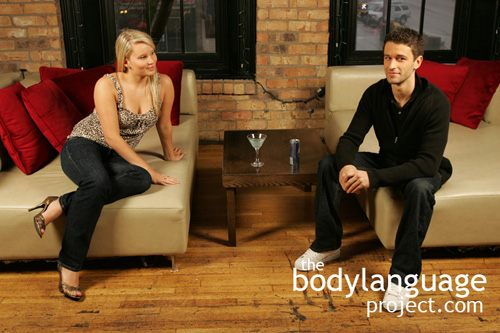Body Language of Pointing Knee
Synonym(s): Sitting On The Leg, Foot Tucked Under the Leg, Tucking One Foot Under The Leg.
Description: A sitting posture whereby the leg is tucked under and sat on.
In One Sentence: The pointing knee is a sitting posture demonstrating high comfort and a desire to stay for a long while.
How To Use it: Tell others that you are not in a rush to leave by taking the pointing knee sitting position. You can also signal your high degree of comfort. This is useful when at a friend’s house. Likewise, the signal is useful to women whom wish to show men that they are at ease in their presence.
Context: General.
Verbal Translation: “I’m comfortable enough to sit on my means of locomotion – my feet, which tells you that I’m not expecting to have to leave in a hurry. Thus, I’m demonstrating my high comfort and relaxed attitude.”
Variant: Both legs may be drawn up and sad on during a high comfort arrangement. This would usually occur in one’s own house, or that of a trusted friend. See Leg Spreading, Figure Four Leg Clamp or Figure Four Leg Lock, Leg Crossing and Leg Crossing Direction.
Cue In Action: Mark invited Julie over for a movie and popcorn. He knew she was at ease because she found a corner seat on the sofa and plopped herself down on top of her foot with her knee pointing forward.
Meaning and/or Motivation: Tucking one foot under the body is a sure sign of high comfort and an informal context because it makes it difficult to get up and vacate should something necessitate it. The bearer of the body language assumes that requiring a quick escape is highly unlikely.
While we live in a relatively safe environment, our subconscious mind still abides by primitive wiring which is the root of all body language. Sitting like this is common in our own house while watching television on the sofa, but is rarely see in an office environment.
Cue Cluster: Expect to see other relaxed body language such as loose, full lips, a face that lacks tension, body slouching, relaxed attire, leaning back rather than forward, slow movements, arms uncrossed, and so forth.
Body Language Category: Comfort body language.
Resources:
Broth, Mathias and Lorenza Mondada. Walking Away: The Embodied Achievement of Activity Closings in Mobile Interaction. Journal of Pragmatics. 2013. 47: 41-58.
http://bodylanguageproject.com/articles/nonverbally-negotiate-conversation-walking-away/
Brault, Sébastien ; Bideau, Benoit ; Kulpa, Richard ; Craig, Cathy M ; Gribble, Paul L. Detecting Deception in Movement: The Case of the Side-Step in Rugby. PLoS ONE. 2012. 7(6).
Tessari, Alessia ; Ottoboni, Giovanni ; Mazzatenta, Andrea ; Merla, Arcangelo ; Nicoletti, Roberto Alain, Claude (Editor). Please Don’t! The Automatic Extrapolation of Dangerous Intentions (Automatic Extrapolation of Dangerous Intentions). 2012. 7(11): p.e49011.
Pitterman, Hallee ; Nowicki Jr, Stephen. A Test of the Ability to Identify Emotion in Human Standing and Sitting Postures: The Diagnostic Analysis of Nonverbal Accuracy-2 Posture Test (DANVA2-POS). Genetic, Social, and General Psychology Monographs. 2004. 130(2): 146-162.
Schwartz, Barry ; Tesser, Abraham ; Powell, Evan. Dominance Cues in Nonverbal Behavior. Social Psychology Quarterly. 1982. 45(2): 114-120.
Sartori, Luisa ; Becchio, Cristina ; Castiello, Umberto. Cues to Intention: The Role of Movement Information. Cognition. 2011. 119(2): 242-252.
Mehrabian, A. (1968) Inference of attitudes from the posture, orientation, and distance of a communicator. Journal of Consulting and Clinical Psychology, 32, 296–308.
Mehrabian, A. (1969). Significance of posture and position in the communication of attitude and status relationship. Psychological Bulletin, 71, 359–372.

